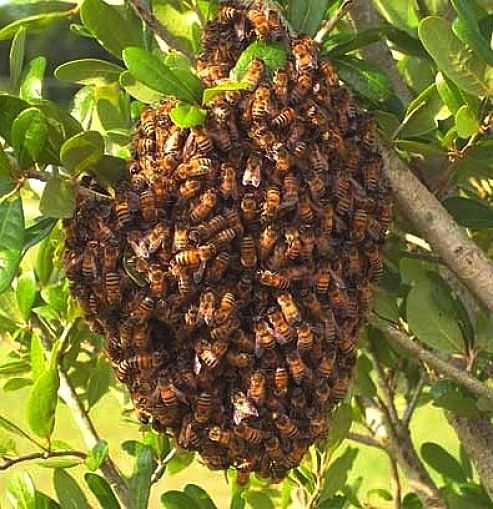How to Get Rid of a Beehive
The first step when you have a bee swarm land in your yard is to contact a local beekeeper. However, don't be surprised if they say they are not interested in collecting them.
Wild bees are likely to be diseased and beekeepers will probably refuse to collect them.
You can attempt to get them to move on using moth balls and other smelly things that insets hate, but once the queen bee settles down this is unlikely to be successful. However this simply passes the problem onto someone else.
It can also be risky to stir up the bees without killing them - they may move to a much worse location!
The reality is that the bees will have to be killed.If you don't feel confident about doing it yourself then you will have to contact a pest exterminator and have it done professionally.
This article outlines what to do if you have a bee swarm or you discover a native bee hive on your property and how to deal with it yourself.

Are They Bees or Wasps?
The first thing to check is that the insect colony or swarm is really bees and not wasps. Bees are stouter than wasps that have a more slender body with a pronounced waist. If in doubt seek professional advice. Wasps can be a lot more dangerous than bees as their venom is much more potent.
Finding the Nest or Bee Hive
Swarms are easy to find as there will be an obvious ball of active bees. If the colony is more established you may have to do some detective work to local the hive. Bees are diurnal and are inactive at night, so the best time to search for them is in the hour after dawn or the hour before sunset. If you follow the bees, their numbers will become a stream closer to the hive. Once you have located the nest you an start to prepare to get rid of the bees by killing them. The best time to do this is when they are inactive in their hive.
What you Need to Kill The Bees
Insecticide - You need a powerful insecticide such as Raid, MicroCare and Baygon.
Protective Clothing - Wear tight fitted long sleeve shirts and trousers, shoes, a hat and a face mask or goggles.
A safe place to hide if the bees start to swarm - You need a safe place to go if the bees start to attack - it needs to be close by and bee-proof.
People to keep everyone away from the area - Make sure you have several people available to keep neighbors, visitors and children away. You don't want to risk them straying into the area and being stung
First Aid Equipment - You need to have everything at hand in case you get stung. Do not attempt to get rid of the bees yourself if you or your family has any allergy to bee stings.
Safety around hives - You don't know whether you are at risk of developing a severe allergic reaction to bee or wasp stings without having been stung previously or tested by a doctor for any allergy. If in doubt don't risk it. The same warning applies to any member of the family, don't risk it and get professional pest exterminators in. The risk is not worth it. Allergic reactions can be fatal. Always have emergency first aid for bee and wasp stings available for dealing with non-allergy responses. Contact your local pharmacist for advice on first-aid for bee stings.
Spraying to Get Rid of the Bees, and their Hive or Nest
Plan your spraying of the swarm or hive in advance, making sure you can make a quick and safe exit to your safe zone if the bees attack. Always do the treatment at night or in the early morning or early evening when the bees are inactive. Make sure you have a spray unit that can direct a wide jet of insecticide over a distance of 3-6 feet (1 to 2 metres). To spray the bees, put on your protective gear move swiftly into range. Quickly apply a through spray and then make a hasty exit. It will probably take several sprays over several evenings to kill all the bees. A though drenching of the remnants with kerosene will finish the job. Check the nest site over the nest week or so to ensure that the nest is not re-established. Once all the bees a gone the nest or hive should be physically destroyed to stop other colonies from using it.